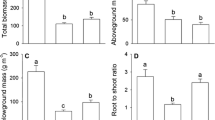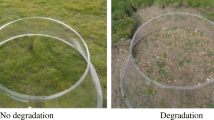Abstract
Aims
Peatland porewaters frequently contain large concentrations of dissolved organic nitrogen (DON), but small concentrations of inorganic N (NH4+ and NO3−). Our aim was to test whether peatland plants, with low tissue N concentrations (0.7 to 1.7%), have the ability to take up organic forms of N, specifically glycine.
Methods
We applied dual-labeled (13C and 15N) glycine to two peatlands: an ombrotrophic bog in eastern Canada and a New Zealand restiad bog undergoing restoration. We compared the δ13C and δ15N values of control and treated above and below-ground plant tissues to establish whether the glycine had been taken up.
Results
At the Canadian bog, the moss, shrub and sedge species treated with glycine showed significant increases in δ15N, above and below-ground, and there was evidence of a significant change in δ13C in shrub roots. At the New Zealand peatland, above- and below-ground tissues of the two restiad species and the roots of the sedge species showed significantly increased δ15N, while only the sedge roots showed a significant increase in δ13C.
Conclusions
All but one of the nine plant species examined showed significant uptake of 15N in foliage and all roots showed increases in 15N. Variations in uptake appear to be partially related to the plant type and root characteristics. Large variations in C, 13C, N and 15N concentration within treatments precluded strong evidence of whether uptake included intact glycine.



Similar content being viewed by others
References
Agnew ADQ, Rapson GL, Sykes MT, Wilson JB (1993) The functional ecology of Empodisma minus (Hook.F.) Johnson and Cutler in New Zealand ombrotrophic mires. New Phytol 124:703–710
Alfonso A (2012) Organic nitrogen use by different plant functional types in a boreal peatland. M.Sc. Thesis. In: McGill University. Montreal, Canada
Bragazza L, Limpens J (2004) Dissolved organic nitrogen dominates in European bogs under increasing atmospheric N deposition. Glob Biogeochem Cycles 18:GB4018. https://doi.org/10.1029/2004GB002267
Bubier J, Moore TR, Crosby G (2006) Fine-scale vegetation distribution in a cool temperate peatland. Can J Bot 84:910–923
Chapin FS III, Mollanen L, Kielland K (1993) Preferential use of organic nitrogen for growth by a non-mycorrhizal arctic sedge. Nature 361:150–153
Clarkson BR (1997) Vegetation recovery following fire in two Waikato peatlands at Whangamarino and Moanatuatua. New Zealand. Journal of Botany 35:167–179
Clarkson BR, Schipper LA, Lehmann A (2004) Vegetation and peat characteristics in the development of lowland restiad peat bogs, North Island, New Zealand. Wetlands 24:133–151
Clarkson BR, Schipper LA, Moyersoen B, Silvester WB (2005) Foliar 15N natural abundance indicates phosphorus limitation of bog species. Oecologia 144:550–557
Clarkson BR, Schipper LA, Silvester WB (2009) Nutritional niche separation in co-existing bog species demonstrated by 15N-enriched simulated rainfall. Austral Ecology 34:377–385
Craine JM, Elmore AJ, Aidar MPM, Bustamante M, Dawson TE, Hobbie EA, Kahmen A, Mack MC, McLauchlan KK, Michelsen A, Nardoto GB, Pardo LH, Peñuelas J, Reich PB, Schuur EAG, Stock WD, Templer PH, Virginia RA, Welker JM, Wright IJ (2009) Global patterns of foliar nitrogen isotopes and their relationships with climate, mycorrhizal fungi, foliar nutrient concentrations, and nitrogen availability. New Phytol 183:980–992
Deane-Coe KK, Sparks JP (2015) Cyanobacteria associations in temperate forest bryophytes revealed by 15N analysis. Journal of the Torrey Botanical Society 143:50–57
Evans RD (2001) Physiological mechanisms influencing plant nitrogen isotope composition. Trends Plant Sci 6:121–128
Gallet-Budynek A, Brzostek E, Rodgers VL, Talbot JM, Hyzy S, Finzi AC (2009) Intact amino acid uptake by northern hardwood and conifer trees. Oecologia 160:129–138
Hogg A, Lowe DJ, Palmer J, Boswijk G, Ramsey CB (2011) Revised calendar date for the Taupo eruption derived by 14C wiggle-matching using a New Zealand kauri 14C calibration data set. The Holocene 22:439–449
Jones DL, Healy JR, Willet VB, Farrar JF, Hodge A (2005) Dissolved organic nitrogen uptake by plants - an important N uptake pathway? Soil Biol Biochem 37:413–423
Karagatzides JD, Butler JL, Ellison AM (2009) The pitcher plant Sarracenia purpurea can directly acquire organic nitrogen and short-circuit the inorganic nitrogen cycle. PLoS One 4:1–9. https://doi.org/10.1371/journal.pone.0006164
Kielland K (1994) Amino acid absorption by arctic plants: implications for plant nutrition and nitrogen cycling. Ecology 75:2373–2383
Kohzu A, Matsui K, Yamada T, Sugimoto A, Fujita N (2003) Significance of rooting depth in mire plants: evidence from natural 15N abundance. Ecol Res 18:257–266
Krab EJ, Cornelissen JHC, Lang SI, van Logtestijn RSP (2008) Amino acid uptake among wide ranging moss species may contribute to their strong position in higher-latitude ecosystems. Plant Soil 304:199–208
Kuder TM, Kruge A, Shearer JC, Miller SL (1998) Environmental and botanical controls on peatification - a comparative study of two New Zealand restiad peat bogs using Py-GC/MS, petrography and fungal analysis. Int J Coal Geol 37:3–27
Lamont B (1982) Mechanisms for enhancing nutrient uptake in plants, with particular reference to Mediterranean South Africa and western Australia. Bot Rev 48:597–689
Limpens J, Heijmans MMPD, Berendse F (2006) The nitrogen cycle in boreal peatlands. In: Wieder RK, Vitt DH (eds) Boreal peatland ecosystems. Ecological studies, vol 188. Springer-Verlag, New York, pp 195–230
Lipson D, Monson RK (1998) Plant-microbe competition for soil amino acids in the alpine tundra: effects of freeze-thaw and dry-rewet events. Oecologia 133:406–414
Loisel J, Garneau M, Hélie J-F (2010) Sphagnum δ13C values as indicators of palaeohydrological changes in a peat bog. The Holocene 20:285–291
McFarland JW, Ruess RW, Kielland K, Doyle AP (2002) Cycling dynamics of NH4 + and amino acid nitrogen in soils of a deciduous boreal forest ecosystem. Ecosystems 5:775–788
McFarland JW, Ruess RW, Kielland K, Pregitzer K, Hendrick R, Allen M (2010) Cross-ecosystem comparisons of in situ plant uptake of amino acid-N and NH4 +. Ecosystems 13:177–193
Meney KA, Dixon KW, Scheltema M, Pate JS (1993) Occurrence of vesicular mycorrhizal fungi in dryland species of Restionaceae and Cyperaceae from south-West Western Australia. Aust J Bot 38:733–737
Miller OK (1982) Mycorrhizae, mycorrhizal fungi and fungal biomass in subalpine tundra at eagle summit, Alaska. Holarct Ecol 5:125–134
Moore TR, Clarkson BR (2007) Dissolved organic carbon in New Zealand peatlands. New Zealand Journal of Freshwater and Marine Research 41:137–141
Murphy MT, Moore TR (2010) Linking root production to aboveground plant characteristics and water table in a temperate bog. Plant Soil 336:219–231
Näsholm T, Ekblad A, Nordin A, Giesler R, Hogberg M, Hogberg P (1998) Boreal forest plants take up organic nitrogen. Nature 392:914–916
Näsholm T, Huss-Danell K, Högberg P (2000) Uptake of organic nitrogen in the field by four agriculturally important plant species. Ecology 81:1155–1161
Näsholm T, Högberg P, Hogberg MN, Nordin A (2009a) Carbon isotopes as proof for plant uptake of organic nitrogen: relevance of inorganic carbon uptake: reply to Rasmussen and Kuzyakov. Soil Biol Biochem 41:1588–1589
Näsholm T, Kielland K, Ganeteg U (2009b) Uptake of organic nitrogen by plants. New Phytol 182:31–48
Olsrud M, Michelsen A (2009) Effects of shading on photosynthesis, plant organic nitrogen uptake, and root fungal colonization in a subarctic mire ecosystem. Botany 87:463–474
Rasmussen J, Kuzyakov Y (2009) Carbon isotopes as proof for plant uptake of organic nitrogen: relevance of inorganic carbon uptake. Soil Biol Biochem 41:1586–1587
Rattle J (2006) Dissolved nitrogen dynamics in an ombrotrophic bog. M.Sc. Thesis. In: McGill University. Montreal, Canada
Schimel JP, Bennett J (2004) N mineralization: challenges of a changing paradigm. Ecology 85:591–602
Schimel JP, Chapin FS III (1996) Tundra plant uptake of amino acid and NH4 + nitrogen in situ: plants compete well for amino acid N. Ecology 77:2142–2147
Schipper LA, Clarkson BR, Vojvodic-Vukovic M, Webster R (2002) Restoring cut-over peat bogs: a factorial experiment of nutrients, seeds and cultivation. Ecol Eng 19:29–44
Shane MW, Dixon KW, Lambers H (2005) The occurrence of dauciform roots amongst Western Australian reeds, rushes and sedges, and the impact of phosphorus supply on dauciform-root development in Schoenus unispiculatus (Cyperaceae). New Phytol 165:887–898
Wagstaff SJ, Clarkson BR (2012) Systematics and ecology of the Australasian genus Empodisma (Restionaceae) and description of a new species from peatlands in northern New Zealand. Phytokeys 13:39–79
Wang M, Moore TR, Talbot J, Richard PJH (2014) The cascade of C:N:P stoichiometry in an ombrotrophic peatland: from plants to peat. Environmental research letters 9:024003 doi.org/10.1088/1748-9326/9/2/024003, 9
Warren C (2014) Organic N molecules in the soil solution: what is known, what is unknown and the path forward. Plant Soil 375:1–19
Zhou J, Desjardins Y, Lapointe L (2013) Nutrient uptake kinetics of cloudberry. J Plant Nutr 36:1219–1233
Acknowledgements
We thank Hélène Lalande of Natural Resource Sciences, McGill University, J-F Helie of GEOTOP, Université du Québec à Montreal and Anjana Rajendram of the Waikato Stable Isotope Unit, University of Waikato for laboratory assistance. We thank Louis Schipper for advice on the study and its interpretation and three reviewers whose comments improved the manuscript. The research was funded by the Natural Sciences and Engineering Research Council of Canada, Fonds de Recherche du Québec Nature et Technologies, Landcare Research NZ and the University of Waikato.
Author information
Authors and Affiliations
Corresponding author
Additional information
Responsible Editor: Xinhua He.
Rights and permissions
About this article
Cite this article
Moore, T.R., Alfonso, A. & Clarkson, B.R. Plant uptake of organic nitrogen in two peatlands. Plant Soil 433, 391–400 (2018). https://doi.org/10.1007/s11104-018-3851-y
Received:
Accepted:
Published:
Issue Date:
DOI: https://doi.org/10.1007/s11104-018-3851-y




